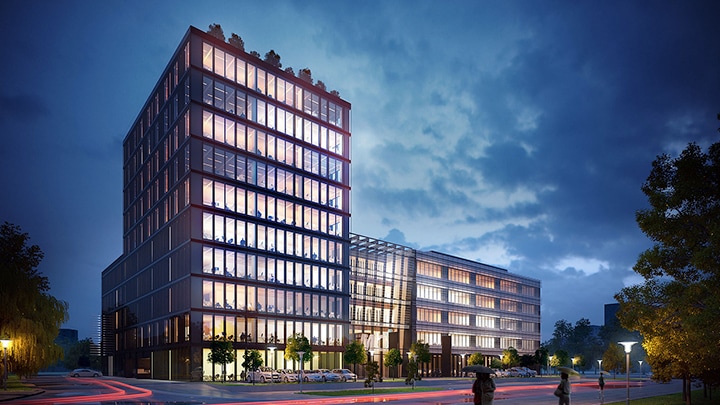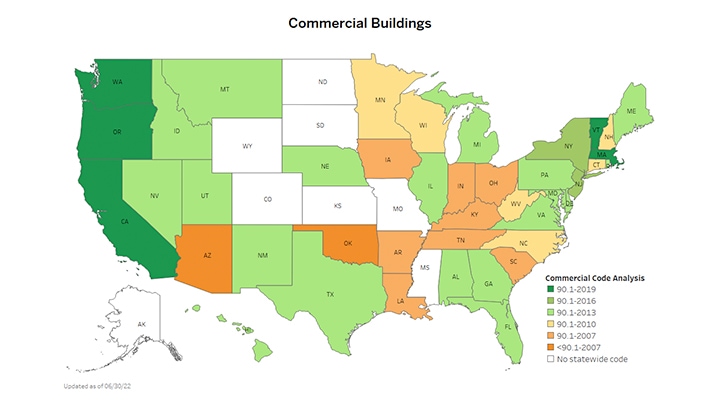
Deciphering US energy codes for commercial buildings is daunting (even for those of us who have been in standards and regulations for decades!). Signify has put together a cheat sheet on what’s new in model energy codes, ANSI/ASHRAE/IES Standard 90.1-2022 and IECC 2021, and the status of their implementation across the country, to help you understand what the codes will mean for your upcoming and future lighting projects. Whether you’re planning for office, warehouse, hospitality or horticulture lighting, we’re here to help you stay code compliant.
An Introduction to US Building Energy Codes
Building energy codes came into effect in the U.S. during the energy and economic crises of the 1970s. In 1978, Congress added an amendment to the Energy Policy and Conservation Act (EPCA), requiring states to create energy conservation standards for new commercial construction if they were receiving federal aid.
Codes govern the design and construction of our buildings – from new construction and tenant fit-outs to retrofits and renovations – and put in place provisions to safeguard occupants. Each code features indoor and outdoor lighting system requirements.
Each State or municipality adopts their own energy codes. To stem the creation of different codes in all the States, national ‘model’ codes were put into practice, which states can choose to adopt in full or modify to fit regional practices. In the last few decades, states have looked to building and energy code requirements as a method for combatting climate change and supporting their long-term carbon neutrality goals. Today, the national model energy code for commercial development is the ANSI/ASHRAE/IES Standard 90.1, developed by the American Society of Heating, Refrigerating and Air-Conditioning Engineers (ASHRAE) and co-sponsored by the Illuminating Engineering Society (IES). Interestingly, while Title 24 Part 6 (the California Building Energy Efficiency Standards) is a state code and not a national model code, it influences requirements in the national codes by encouraging even more energy efficient provisions.
What’s New in ANSI/ASHRAE/IES Standard 90.1-2022 and IECC 2021
The latest code revision, 90.1-2022, that we anticipate will be published by ASHRAE by the end of 2022, mandates functional lighting control requirements for energy savings and prescribes limits for lighting power. Here is a breakdown of new requirements, and changes to existing requirements in the 2022 Standard for commercial and multi-family residential buildings above three stories
As a model code, the International Energy Conservation Code (IECC) specifies requirements for indoor and outdoor lighting systems and applies them to new construction, major renovation and retrofit projects.
Click to download the infographic explaining the new updates in ANSI/ASHRAE/IES Standard 90.1-2022 and to IECC 2021
Status of State Energy Code Adoption for Commercial Buildings
The adoption of building and energy codes varies by state. For instance, California, Oregon, Washington, Vermont and Massachusetts have the most up-to-date codes. Their codes either incorporate ASHRAE 90.1-2019 or are as stringent as its provisions, as in the case of California. Colorado, Wyoming, North and South Dakota, Kansas, Missouri and Mississippi have no statewide codes.
The U.S. DOE publishes a state-by-state breakdown of energy code adoption for commercial buildings in the US:

Source: https://www.energycodes.gov/status/commercial
The Value of Energy Code Adoption
Model energy code updates are relevant to the key decision makers of commercial building development as code compliance and energy conservation measures are top priorities. ASHRAE 90.1-2022 and IECC 2021 set ambitious targets that will help guide commercial buildings to a brighter, more sustainable future. For example, hotel operators can leverage lighting controls and occupancy sensing technology to comply with state-level energy dimming and auto shut-off requirements, while also enhancing guest comfort and wellbeing. Offices can employ the environmental monitoring capabilities of connected lighting systems to detect daylight entering the space and reduce electric light levels when it is sufficient saving energy and adjust HVAC settings to heat or cool the space, accordingly, realizing even greater energy savings.
In an upcoming blog post, Jenna Rhodes, Channel Marketeer for our Professional Channel, will explain how you can be rewarded for increasing your building’s energy efficiency through utility rebates.

November 14, 2023
How lighting technology can help reduce risks to migrating birds